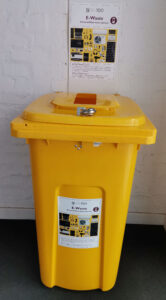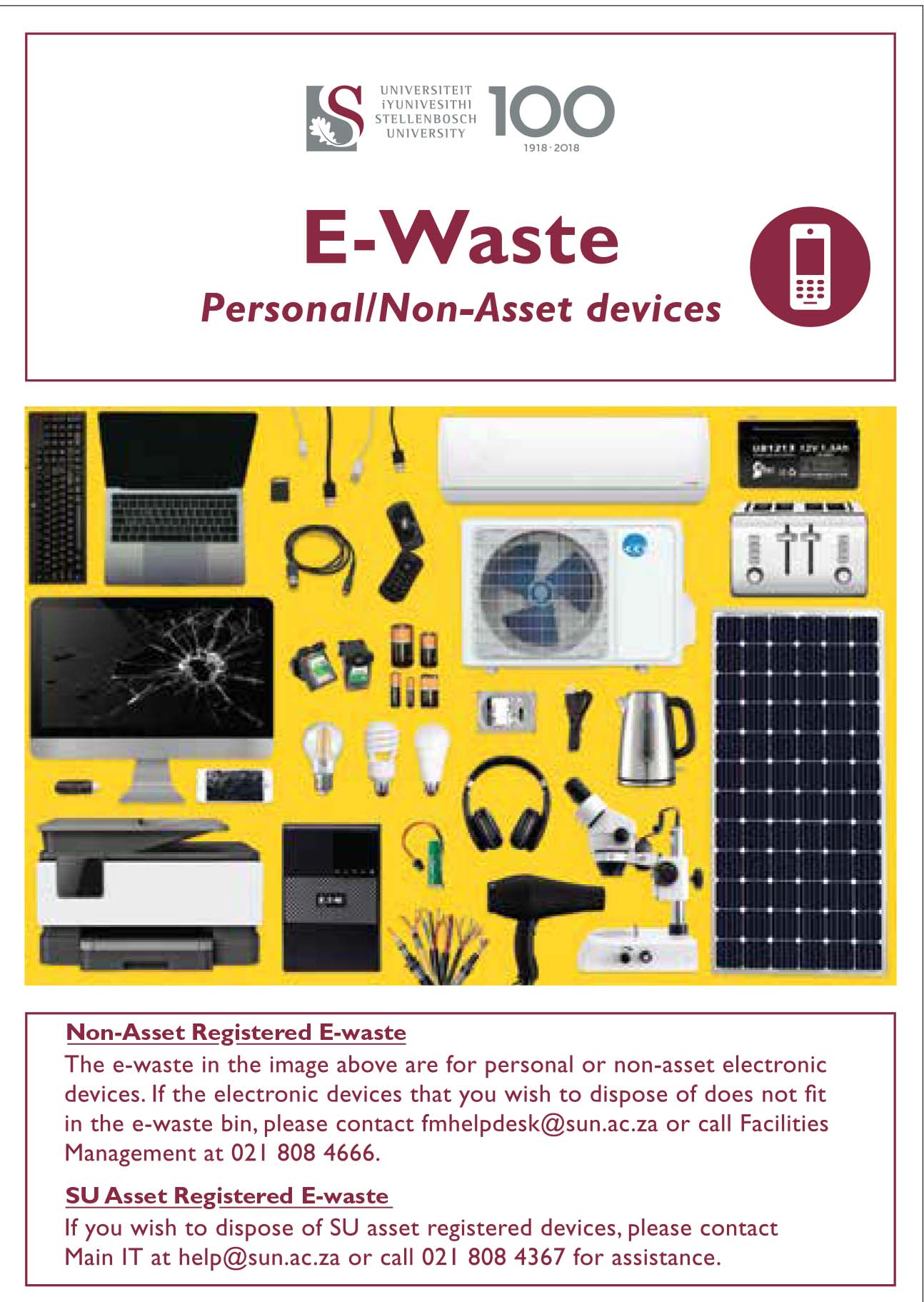[:en]
Do you have old computers, monitors, cell phones or batteries lying around or clogging up cupboards? Are you concerned enough to dispose of them responsibly and not simply consign them to the dump?
There is a responsible campus solution. Facilities Management implemented e-waste bins on campus where e-waste can be disposed of and will then be picked up by contractors who specialise in the refurbishment, reuse and safe disposal of e-waste.
Electronic waste (e-waste) or Waste Electrical and Electronic Equipment (WEEE) are the terms used to describe old, end-of-life or discarded appliances using electricity. It includes computers, consumer electronics, etc. which have been disposed of by their original users. It can also include batteries.
E-waste is of concern largely due to the toxicity of some of the substances such as lead, mercury, cadmium and a number of other substances which are harmful to human health and ecosystems if not disposed of properly. The unsustainably rapid turnover of discarded electronics and computer technology is another reason for the need to recycle – or even better, re-use – e-waste.
What will happen to the e-Waste?
The contractors will separate the waste into items that
- can be refurbished,
- can be recycled and
- must be safely disposed of.
Refurbishment of appliances and computers provides jobs and these items are then reused in needy schools and communities. Useful, scarce and valuable metals and other substances are extracted by recycling, while toxic e-waste is disposed of at special hazardous waste facilities. Examples of potentially toxic items include the old type of computer screens (CRT) and fluorescent tubes.
The procedure is as follows:
- Ensure that the items have been properly written off and dealt with in line with the University’s policy regarding the handling of redundant assets.
- Remove all your data, private and work related, from the devices. IT does not take responsibility for deleting or backing up any data or for any risk that your data might be accessible after disposal. Your device should be completely devoid of data.
- Dispose of e-waste in the yellow bins at the IT HUB (at the entrance) and IT Main Buiding (inside the service entrance on the right-hand side of the main entrance)
- For any further enquiries contact Clive Layman at Stellenbosch campus, Le Roux Franken at Belpark campus or Kevin Vermaak at Tygerberg.
More information: www.ewasa.org
[:af]
Het jy verouderde rekenaars, skerms, selfone of batterye wat geen nut het nie en net onnodige spasie opneem in jou kaste? Gee jy genoeg om vir die ongewing om eerder op die regte manier daarvan ontslae te raak i.p.v. om dit op ʼn vuilgoedhoop te gooi?
Daar is ʼn verantwoordelike oplossing. Fasiliteitsbestuur het geel e-afval dromme op strategiese plekke op kampus geplaas waar ou elektroniese toestelle in geplaas kan word en dan deur buite-kontrakteurs opgetel, hergebruik en veilig van ontslae geraak kan word.
Elektroniese afval (e-afval) is die term wat gebruik word om verouderde of weggooi-toerusting wat met elektrisiteit werk, te beskryf. Dit sluit rekenaars, batterye en enige elektroniese toerusting in waarvan die oorspronklike eienaars ontslae geraak het.
Toksiese bestanddele, soos lood, kwik, kadmium en ander stowwe hou ʼn gesondheidsrisiko en is ook gevaarlik vir ekosisteme. Wanneer e-afval afbreek en nie op die korrekte manier mee weggedoen word nie, beland giftige stowwe in grond en grondwater. Die materiaal kan eerder herwin word om rou materiaal te skep wat hergebruik kan word.
Die onvolhoubare, vinnige omset van verouderde elektronika en rekenaartegnologie is nog ʼn goeie motivering om te herwin of e-afval te hergebruik.
Wat gebeur met e-afval?
Kontrakteurs skei die artikels in die volgende drie kategorieë. Items wat
- opgeknap kan word,
- herwin kan word en
- veilig ontslae van geraak moet word.
Opknapping van toerusting en rekenaars skep werk en die items word hergebruik in behoeftige skole en gemeenskappe. Nuttige, skaars en waardevolle metale en ander stowwe word verwyder d.m.v. herwinning, terwyl giftige e-afval, soos ou rekenaarskerms(CRT’s) en fluoor-buisligte in spesiale afvalfasiliteite gestort word.
Die prosedures is as volg:
- Maak eers seker dat alle items afgeskryf en hanteer is volgens die Universiteit se beleid rakende die hantering van oortollige bates.
- Verwyder al jou data, privaat en werksverwant, van die toestelle. IT is nie verantwoordelik vir die uitvee en rugsteun van data of vir die risiko dat data toeganklik kan wees na wegdoening nie. Jou toestelle moet volledig skoongemaak wees.
- Bring jou ou toerusting na of die IT HUB of IT Hoofgebou vir plasing in die geel e-afval dromme. Beide dromme is aan die binnekant van die ingange. Die geel drom by die IT Hoofgebou is in die binneportaal van die diensingang (regterdeur as jy voor die gebou staan)
- Indien jy steeds navrae het kontak Clive Layman op Stellenbosch-kampus, Le Roux Franken by Belpark of Kevin Vermaak op Tygerberg.
Vir meer inligting: www.ewasa.org
[:]
 As part of the campus “Going Green” project Facilities Management will be placing e-waste bins at selected spots on campus. We encourage staff and students to use these bins for any non-asset e-waste.
As part of the campus “Going Green” project Facilities Management will be placing e-waste bins at selected spots on campus. We encourage staff and students to use these bins for any non-asset e-waste.
 As deel van die “Going Green”-projek sal Fasiliteitsbestuur e-afval houers op uitgesoekte plekke op kampus uitplaas. Ons moedig personeel en studente aan om hierdie houers te gebruik vir enige e-afval wat nie US-bates is nie.
As deel van die “Going Green”-projek sal Fasiliteitsbestuur e-afval houers op uitgesoekte plekke op kampus uitplaas. Ons moedig personeel en studente aan om hierdie houers te gebruik vir enige e-afval wat nie US-bates is nie.

